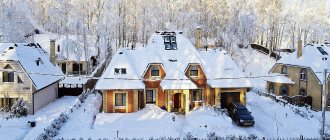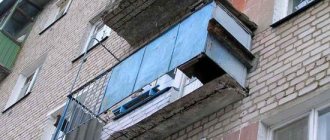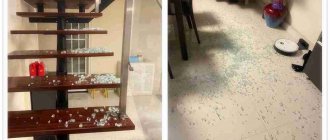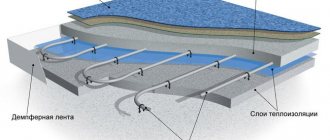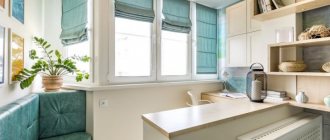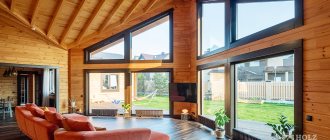Mold is a type of fungus that harms people and their property. Most often it lives in warm places with high humidity and free access to a favorable environment. Appears on food, wood, building materials, and in human homes. Mold or mildew on the balcony is a serious problem for people, causing harm in the form of destruction of walls and a decrease in the quality of life of the inhabitants of the house.
- Causes
- Step-by-step guide to combating Stage one: preparing the premises for treatment
- Second stage: treatment with special means A mixture of vinegar and copper sulfate
- Baking soda solution
- Hydrogen peroxide
- Uses of Borax
- Using bleach to remove mold
- Grapefruit seed extract
- Use of modern antiseptics
- Providing ventilation
Important! The pest contains toxic and dangerous substances that get into the air, onto the skin and can harm health, so you need to know how to get rid of mold and mildew on a balcony or loggia immediately after it appears.
Mold organisms can cause allergies, problems with the pulmonary system, and migraines. If it enters the respiratory tract, pneumonia, tracheitis, laryngitis, and asthma develop.
Causes
The question of why black mold grows on a balcony or when a loggia freezes arises only after the problem has appeared. But it is better to prevent it by taking preventive measures.
Even if mold has already appeared on the balcony, it is important to determine the reasons why it appeared, because the method of control depends on this.
| Ventilation problems | Constant air ventilation maintains the temperature and prevents humidity from rising above 60%. It is under such conditions and temperatures above 20 degrees that increased proliferation of microorganisms occurs. |
| Installation of double-glazed windows | If plastic windows are installed incorrectly, their tightness is broken, they allow moisture to pass through, which leads to the formation of a white or black coating. Condensation collects on the glass, which increases the humidity on the balcony. |
| Roof leak | Slots and holes in the roof allow moisture to constantly penetrate into the room, especially during rain and snow. In this case, only sealing all the cracks will help. |
| Drain pipe breakdowns | When pipes leak, unwanted moisture and bacteria enter the home, which adversely affects the occupants and causes mold to form. |
| Availability of wooden frames | Wooden frames that have served for a long time do not perform their functions well. Gaps and cracks form in them, through which moisture and cold enter. It is best to replace the windows on the balcony with double-glazed windows or thoroughly repair them, sealing all the cracks and covering them with a varnish base. The appearance of white mold on the balcony will no longer be a problem. |
| Many colors | Plants constantly get rid of excess moisture through evaporation. In small quantities it does not affect the humidity of a house or apartment. But if there is a lot of greenery growing on the balcony, especially large ones, then the amount of evaporated moisture increases and leads to the proliferation of microorganisms. |
| Violation of the integrity of walls and roof | If there are problems with thermal insulation on the balcony, constant air humidity is maintained, which forms a fungal coating inside the room, because because of this, the walls freeze in winter. |
How to deal with the problem in winter
For some reason, the problem of fungus formation on the balcony always worsens in winter.
The cause of this occurrence in winter is the formation of condensation. Condensation forms due to the difference in temperature on the balcony and outside.
To begin eliminating mold, you must wear a respirator.
Take a spatula and use it to clean the walls of fungus. If the affected areas are small, then simply scraping them off is enough.
Video on the topic:
Return to content
Step by step guide to wrestling
Removing mold on the balcony using only mechanical methods will not help: rubbing it with a towel, picking it out with sharp objects, painting it over with paint. Because without destroying the “root” of the problem, it is impossible to get rid of the white mold on the walls of the balcony.
The fight against mold on the balcony must be thorough and take place in several stages. First, they prepare the room, then treat it with antifungal drugs (either improvised means or specialized ones), and then restore the damaged areas with the help of minor repairs.
Important! When preparing a balcony, examining pests, and getting rid of them, special equipment is required: rubber gloves, masks or respirators, safety glasses, clothing.
First stage: preparing the room for treatment
Before starting the process of getting rid of plaque on loggias and balconies, they are cleared of unnecessary debris, objects, and decor that would interfere.
Important! In the fight against mold, the main thing is to find and destroy the cause of its appearance, only then deal with the consequences.
It is necessary to determine how deep the damage is to the walls, ceiling, and floor. You can assess the growth visually, but mold often penetrates deep inside, especially if it is wooden surfaces or even plaster, plastic, or concrete structures.
Second stage: treatment with special means
Experts know what to do to remove mold and mildew from the balcony wall - they apply folk remedies or specialized antifungal drugs to it.
Important! To combat mold on the balcony, only substances containing active chemical components are suitable.
A mixture of vinegar and copper sulfate
Vinegar is used in the national economy not only as an additive to food products and pickling, but also helps treat and disinfect surfaces. And when combined with copper sulfate, its chemical activity increases, so this method is effective.
Treating a balcony with vinegar:
- For 10 liters of water add 2 tbsp. spoons of vinegar and 0.5 kilograms of copper sulfate.
- Heat to 70 degrees, stir.
- Treat the affected area with the solution using a brush or spray bottle.
If necessary, repeat the treatment of the balcony after a month.
Baking soda solution
Baking soda is also an assistant for housewives; it is suitable for cleaning scale and dirt. It also helps with mold damage to the balcony.
Treatment with baking soda:
- Add 2 tbsp per liter of water. spoons of soda.
- Mix.
- Apply with a brush or spray.
- Wait and thoroughly clean the areas on the balcony with a stiff brush.
- After cleaning, wipe with a cloth.
After drying, you can repeat the procedure.
Hydrogen peroxide
This is a chemically active substance that fights the parasite well.
Treating a balcony with hydrogen peroxide:
- Pour undiluted liquid into a spray bottle.
- Treat affected areas.
- Wait an hour or two.
- Remove excess with a rag.
If hydrogen peroxide is poorly removed from the balcony, then the chemical may slightly corrode the surface.
Uses of Borax
Borax or sodium tetraborate is a chemical compound of sodium salt with boric acid.
Algorithm of actions on how to remove mold from the wall on the balcony:
- Add ¼ part borax per liter of water.
- Pour into a spray bottle and apply the solution to the affected area of the balcony.
- Remove the fungus with a stiff brush.
- Do not wash off residue from the walls.
In case of deep and extensive damage by fungal plaque, a paste is made from borax and applied in a thin layer to the surface, after which it is treated with a brush. Borax absorbs odors and disinfects the affected area.
Using bleach to remove mold
This substance has high chemical activity and fights fungus well.
Treatment with bleach:
- Add 80 ml of liquid per liter of water.
- Pour into a spray bottle or use a rag.
- Disinfect surfaces.
- Use a clean cloth to remove any remaining bleach.
- Finally, rinse with water.
The rags used for treatment should be thrown away: they contain fungal spores.
Grapefruit seed extract
They have antiseptic and disinfectant properties, so they are also used to remove plaque.
Treatment with Grapefruit Seed Extract:
- You need to take 10 drops of the substance per glass of water.
- Pour into a spray bottle.
- Disinfect the surface.
- Do not rinse off.
The extract neutralizes the moldy odor and prevents spores from spreading, destroying them.
Use of modern antiseptics
There are drugs to combat fungus that differ in price and reliability. For proper processing, you just need to follow the instructions.
Third stage: restoration of the balcony finishing
After all affected surfaces have been coated and the causes of microorganism proliferation have been destroyed, restoration of the finishing of the room is required.
To do this, they carry out vapor barrier and waterproofing: cover the wall with a thick layer of bitumen mastic, all surfaces on the balcony, and not just those that have been affected by fungus. After the walls have dried, the ceiling is coated with a primer and topped with finishing cladding.
Conditions for development and emergence
Now we should talk about what conditions are favorite for mold. Mold fungus loves moisture.
https://youtube.com/watch?v=qqjHqT7l4fI
This is practically a catalyst for the reproduction and spread of mold. Unfortunately for humans, almost all materials around us - food and so on - contain a sufficient amount of moisture. Wooden doors in the bathroom, old wooden windows or balconies. Some buildings are generally built in such a way that they allow moisture to easily seep between the panels of the house and allow it to enter directly into the living space. Horror! What can we say about organizing the process of drying things in the apartment... We ourselves create favorable conditions for the formation and spread of mold in our homes. An important factor influencing the rate of spread and formation of mold is temperature. And room temperature is ideal for mold. Only temperatures above one hundred degrees Celsius can destroy mold; all other temperatures either promote its spread or render it inactive.
Conditions favorable for mold include the following:
- the presence of accumulations of dirt in the apartment;
- minimal room ventilation;
- high humidity combined with room temperature (this was discussed earlier, but the combination of factors is the most powerful catalyst);
- leakage of seams in buildings and structures.
If at least one of the conditions above is met, then you should think about the fact that a new resident called mold is already living somewhere in your apartment or your house or is about to appear.
Prevention: creating a good microclimate
It is possible to prevent the appearance of mold using specially created conditions that are comfortable for humans, but unusual for fungi.
How to create a microclimate:
- Don't raise the temperature too much.
- Monitor the humidity level using instruments and do not exceed 60%.
- Insulate walls, ceilings, and floors.
- Avoid dampness.
- Do not litter the balcony with garbage and things.
- Ventilate the room frequently.
- Do not dry laundry on a closed loggia.
Pay attention! The most important thing in creating a microclimate is constant ventilation and aeration.
With these tips, the possibility of fungal plaque appearing on surfaces is greatly reduced.
Providing ventilation
Ventilation problems most often begin after poor-quality repairs or installation of windows. There is nowhere for moisture to evaporate, so the humidity constantly rises.
To ensure proper ventilation, make a vent. This procedure helps remove stagnant, moist air. If this was not enough, then exhaust valves are installed to improve the movement of air masses outward. Regular ventilation also helps.
Window sealing
This problem arises for owners of wooden windows, because it is in the wood that cracks and holes quickly form. To improve sealing, the frames are sealed with materials from hardware stores, and the joint areas are treated with insulation. To solve the problems radically, the windows are glazed and replaced with double-glazed windows - this eliminates depressurization.
Pay attention! Double-glazed windows also allow moisture to pass through if installed incorrectly.
Roof sealing
Residents of private houses or owners of apartments on the upper floors often face the problem of roof leaks. To solve this problem, they carry out repairs, eliminate cracks, holes and insulate.
Some interesting facts
1. Mold is one of the most ancient substances on Earth. Some scientists attribute an age of up to two hundred million years to the fungus.2. Mold is smart. According to an experiment by one of the researchers of fungal and mold formations, both have memory and the beginnings of intelligence. The experiment consisted of the following: an artificial labyrinth was created, where a certain type of mold was placed, and at the end of the labyrinth there was a piece of sugar. The mold, finding a dead end on its way, turned in the opposite direction and so on until the colony found its way to the tasty morsel. The most interesting thing is that when a piece of mold that had reached the sugar was removed, and the sugar itself was transferred to another place, the mold quickly found its way to the sugar along the walls and ceilings of the labyrinth. Marvelous? Still would.
3. Mold is extremely dangerous. It surrounds us everywhere, and often no significance is attached to its detection on the same food products. And in vain. We have already talked about its harm.4. Mold is omnipresent. It is found everywhere and adapts to absolutely any living conditions and environment. This is a fact, frightening, but a fact.5. Mold saves lives. Have you heard of penicillin? So it was made from a specific strain of mold. It’s time to discuss the most important issues.
Features of deliverance on the walls of the loggia
The difference between a balcony and a loggia is that it is located closer to the main rooms, so wall mold is more easily able to move to other rooms. Therefore, measures need to be taken faster. You can achieve complete destruction of mold on the balcony using chemical means, and as a supplement, physical impact.
How to remove and prevent the spread and appearance of fungus:
- Insulation of street and external walls. This procedure will help to avoid sudden temperature changes, which is what mainly causes spores to settle on the walls. Insulation will allow you to seal all the holes and cracks through which moist street air entered the loggia.
- Installing batteries. They heat the air and reduce humidity, having a drying effect. In living rooms this does not have a very beneficial effect on the human body, but on loggias it helps combat excess air humidity.
- Ventilation. It will help to constantly renew the air, replacing stagnant air with fresh air. This will make it more difficult for airborne mold spores to find a place to reproduce.
- Create air circulation. Mold prefers to grow in quiet places with stagnant air and high humidity. Therefore, if you create frequent air movement, it will be difficult for mold to multiply on the loggia.
- Check the tightness of windows and doors. Through even tiny cracks, street moisture enters, which provokes the proliferation of fungal spores.
- Repair waterproofing. Problems with waterproofing are the most common reason for the colonization of fungal formations on loggias. Therefore, if you remove the cause of reproduction, it is easier to remove the fungus itself.
- Reduce humidity. This can be achieved by removing unnecessary and bulky plants from the loggia
These methods help prevent the fungus from multiplying, but without chemicals it will not be possible to completely get rid of it.
Why is mold dangerous?
Mold not only worsens the appearance of the loggia, it also has a negative impact on human health. It consists of a large number of spores that are visible only under a microscope. Spores multiply at high speed and are capable of infecting any walls.
Direct contact with mold may cause an allergic skin reaction or eczema. It can also affect nails and hair and cause migraines. When inhaling spores, there is a high risk of getting a chronic cough, runny nose or conjunctivitis. They are able to penetrate the respiratory tract and provoke the occurrence of allergic diseases, sometimes even bronchial asthma.
Through breathing, spores enter the bloodstream and can worsen a person’s condition. Headaches, nausea, dizziness occur. If you stay in a room contaminated with fungus for a long time, problems with the stomach or liver may begin. That is why you should not ignore mold; you must immediately, when you discover this problem, think about how to get rid of mold on your loggia.
Removing the smell
Black mold is a source of not only infection, but also a very unpleasant odor that can remain in the room even some time after the fungus is removed. To get rid of this nasty odor, you need to do the following.
- Treat the cleaned area with a warm stream of air (hair dryer).
- Cover the area with baking soda and leave for 2 hours.
- Remove the soda.
There is another equally effective way: wipe the area where the mold was with a mixture of white vinegar, hydrogen peroxide, boric acid and water (2:2:1:4).
Wipe the cleaned area until the smell disappears completely.
Fungus attacks
The source of black plaque can be a balcony slab that does not fit tightly to the apartment.
In such cases, they turn to professionals who carry out external insulation and disinfection of the structure. They cover the joints with cement mortar, and after drying, apply an antiseptic impregnation. After repair work, the corners of the balcony are dried, and then the walls and ceiling are treated with a special impregnation. If the source of the fungus is the neighbor’s apartment below or to the side, you will have to solve the problem together, otherwise the mold will return, and even primer and mastic will not help.
Preventive measures
Preventing a phenomenon can be much easier than subsequently dealing with it. If dampness begins to appear at the corners of the balcony, they need to be treated with an antiseptic and a ventilation system should be considered.
Balcony insulation is one of the preventive measures to combat fungus and mold. In this case, it is good to choose insulation such that it successfully combines steam and heat insulation properties. The balcony is insulated on all sides - floor, ceiling and walls. Balcony glazing must have a vapor barrier; all double-glazed windows must be foamed at the edges.
Balcony insulation as a means of combating fungus and mold
In addition to those listed, several more preventive procedures can be noted to prevent dampness, mold and fungal infections of surfaces:
1) the use of special primers for walls against mold;
2) if the balcony is tiled, the grout should be chosen with additives that do not allow moisture to accumulate in the joints.
Remember: all mold control measures should be carried out using PPE (personal protective equipment).
This way you can protect your health from fungal spores, mold and harmful fumes from chemical solutions.



